Making Sensory Data Statements
Sensory data statements describe what you see, hear, touch, taste and smell.
- These statements “document” your interpretations.
A good sense statement is specific about time, location, and action or behavior.
- The more specific a sense statement is, the more useful.
- Sense statements orient the listener(s) to your experience
Sense statements supply data to what, where, when, how and who – but do not explain why
Interpretations
- Interpretations are the meanings you assign in your own head to help you understand yourself, events and other people.
- The thoughts you have about yourself, others, things, and what happens to you and others (events).
- Interpretations happen all the time.
Other names for interpretations
- Impressions
- Beliefs
- Conclusions
- Assumptions
- Evaluations
- Ideas
- Opinions
- Expectations
- Stereotypes
- Reasons
It is useful to keep your interpretations tentative.
Many different interpretations are available for the same sensory data.
Often, too little sensory data is available to make a firm interpretation
- Because people are often uncomfortable with not knowing, the temptation is there to jump to conclusions
- Often the sensory data in a given situation is incomplete
Sometimes sensory data conflicts with previous experiences or assumptions - This leads to misinterpretations
The sensory data in a situation may be new to you - Keeping open to additional sensory data retains the possibility of seeing things in a new way, i. e. of learning
Feelings
Feelings are spontaneous responses to your interpretations and the expectations you have.
Emotional responses are inside your body, but may have outward signs
- For example, when angry, you may notice this by tense muscles, loud rapid speech, or flushed skin.
- You may notice sadness by moist eyes or tears.
- You may notice elation by smiles, laughing or joking.
Feelings typically exist on a spectrum, e.g.
- Annoyed, irritated, angry, enraged
- Anxious, nervous, fearful, terrified
- Liking, affectionate, loving, passionate
- Pleased, happy, elated, jubilant
Feelings are you, part of the person you are.
Feelings also serve as a barometer.
- Emotions can alert you to what’s going on
- Emotions can help you understand your reaction to a situation
- Emotions can alert you when two people have different interpretations
Feelings can help you clarify your expectations.
Some feelings arise because of differences between what you expected and what actually happened.
- For example, if you expected to have your proposal accepted, and it was rejected, you would likely feel surprised, hurt, and disappointed
- If you expected to have your proposal rejected, and it was accepted, you might feel happy, excited or gratified
Sometimes you don’t know what you expect, but can determine expectations after the fact by what you felt in response to a situation
Intentions or Wants
Intention statements are ways of being direct about what you want to do or want not to do.
“Might”, “could”, or “maybe” when used in intention statements confuse and hide your intentions.
Intentions, like feelings, can be in conflict inside yourself.
Disclosing these conflicting intentions can still be valuable.
- Helps clarify for yourself what is most important
- Clarifies the range of possibilities for your audience
Actions
Action statements about the future are commitments.
- Saying “I will …” lets people know what you are willing to do or not willing to do
- This lets people know what to expect from you
Keeping your commitments or renegotiating when unable to keep commitments is the foundation for building trust. - Trust is the single most important factor in having and maintaining good communication
Stating what you are willing to do opens the space for the other person to offer to do something as well. - If communications or negotiations are stuck, this often moves the process forward

